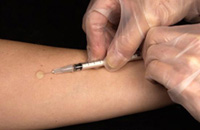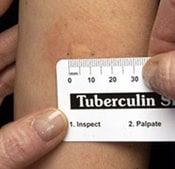Testing for TB Infection
There are two types of tests for TB infection: the TB skin test and the TB blood test. A person’s health care provider should choose which TB test to use. Factors in selecting which test to use include the reason for testing, test availability, and cost. Generally, it is not recommended to test a person with both a TB skin test and a TB blood test.

Administering the TB skin test
The TB skin test is also called the Mantoux tuberculin skin test (TST). A TB skin test requires two visits with a health care provider.
On the first visit the test is placed; on the second visit the health care provider reads the test.
On the first visit the test is placed; on the second visit the health care provider reads the test.
- The TB skin test is performed by injecting a small amount of fluid (called tuberculin) into the skin on the lower part of the arm.
- A person given the tuberculin skin test must return within 48 to 72 hours to have a trained health care worker look for a reaction on the arm.
- The result depends on the size of the raised, hard area or swelling.
 Reading the result of a TB skin testPositive skin test: This means the person’s body was infected with TB bacteria. Additional tests are needed to determine if the person has latent TB infection or TB disease.Negative skin test: This means the person’s body did not react to the test, and that latent TB infection or TB disease is not likely.There is no problem in repeating a TB skin test. If repeated, the additional test should be placed in a different location on the body (e.g., other arm).The TB skin test is the preferred TB test for children under the age of five.
Reading the result of a TB skin testPositive skin test: This means the person’s body was infected with TB bacteria. Additional tests are needed to determine if the person has latent TB infection or TB disease.Negative skin test: This means the person’s body did not react to the test, and that latent TB infection or TB disease is not likely.There is no problem in repeating a TB skin test. If repeated, the additional test should be placed in a different location on the body (e.g., other arm).The TB skin test is the preferred TB test for children under the age of five.
Related Links
For Patients
- TB – General Information (Fact sheet)
- Testing for Tuberculosis (Fact sheet)
- What You Need to Know About the TB Skin Test (Pamphlet – PDF 202k)
- Questions and Answers About TB
For Health Care Providers
Education & Training






















.png)











No hay comentarios:
Publicar un comentario